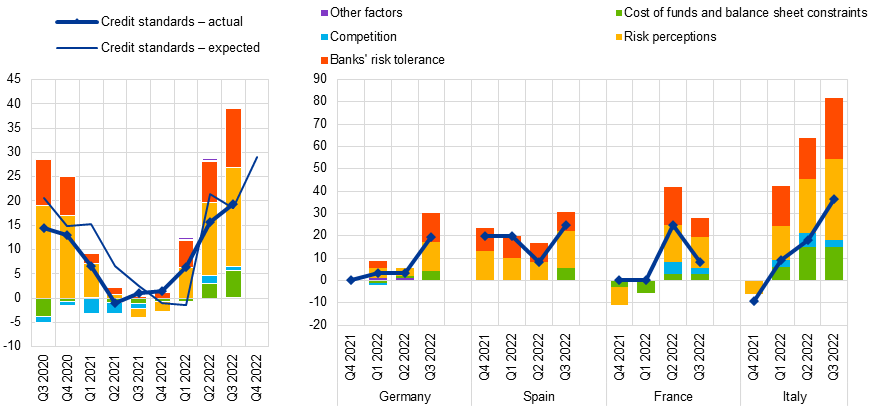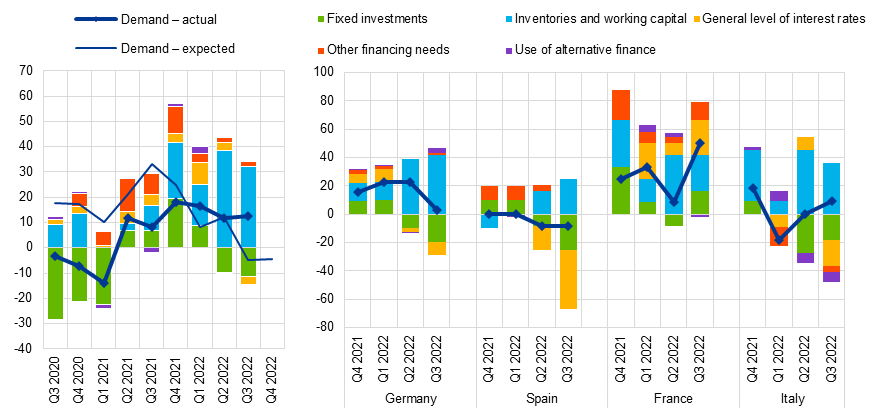- PRESS RELEASE
October 2022 euro area bank lending survey
25 October 2022
- Credit standards tightened substantially for households and firms
- Loan demand from firms increased, driven by high input costs and inventories building
- Loan demand from households decreased in a context of higher interest rates and lower confidence
According to the October 2022 euro area bank lending survey (BLS), credit standards – i.e. banks’ internal guidelines or loan approval criteria – for loans or credit lines to enterprises tightened further (net percentage of banks standing at 19%) in the third quarter of 2022 (see Chart 1). With regard to loans to households for house purchase, euro area banks reported a strong net tightening of credit standards (net percentage of 32%) and a lesser, but still pronounced, net tightening for consumer credit and other lending to households (net percentage of 21%). In the context of economic slowdown and intensifying recession fears, the risks related to the economic outlook, as well as industry or firm-specific situations and banks’ declining risk tolerance all had a considerable tightening impact on credit standards for loans to firms. With the ongoing normalisation of monetary policy, banks’ cost of funds and balance sheet situation also had a tightening impact on credit standards for loans to euro area firms, which was larger than in the previous survey round. In the fourth quarter of 2022 euro area banks expect a significantly stronger net tightening of credit standards on loans to firms. In addition, euro area banks expect credit standards to continue to tighten for both housing loans and consumer credit.
Banks’ overall terms and conditions – i.e. the actual terms and conditions agreed in loan contracts –tightened for loans to firms and loans to households in the third quarter of 2022. For loans to firms, both loan margins and other terms and conditions had a tightening effect. For house purchase loans and consumer credit, despite the net tightening of terms and conditions, loan margins (with margins defined as the spread over relevant market reference rates) narrowed, reflecting in part that market reference rates have increased faster than interest rates on loans to households.
Banks reported, on balance, an increase in demand from firms for loans or drawing of credit lines in the third quarter of 2022 (see Chart 2). Loan demand continued to be driven by firms’ financing needs for working capital and inventories, in the context of inflated production costs, growing inventories due to the slowdown in demand and precautionary behaviour against the background of supply bottlenecks. For the second consecutive quarter, fixed investment had a dampening impact on firms’ net demand for loans, in line with the expected slowdown in investment. In the context of monetary policy normalisation, banks have started to indicate a negative contribution from the general level of interest rates to loan demand. In the third quarter of 2022 net demand for housing loans fell substantially, while demand for consumer credit and other lending to households also decreased in net terms. The net decrease in demand for loans to households was mainly driven by the general level of interest rates and declining consumer confidence. For the fourth quarter of 2022 banks expect a net decrease in firms’ demand for loans. For households, banks expect a further strong net decrease in the demand for housing loans and a lesser, but still relatively strong, fall in demand for consumer credit.
According to the banks surveyed, access to retail funding, securitisation and particularly medium-to-long term debt securities deteriorated, in net terms, in the third quarter of 2022. This reflects the tightening of financial market conditions for banks as monetary policy normalises. Banks reported that the ECB’s asset purchase programmes had a negative impact on their liquidity position, market financing conditions and profitability over the past six months, in the context of the monetary policy normalisation and the ending of net asset purchases. Over the past six months, which partly covered the period in which the ECB’s deposit facility rate was still negative, euro area banks reported in net terms, that the deposit facility rate continued to have a positive, albeit small, impact on lending volumes to firms and households and continued to contribute negatively to bank profitability. Banks in the euro area indicated a smaller positive impact from TLTRO III on their financial situation and lending volumes, as well as a lower net easing impact on terms and conditions for loans to firms and households compared with the previous survey round.
The euro area bank lending survey, which is conducted four times a year, was developed by the Eurosystem in order to improve its understanding of bank lending behaviour in the euro area. The results reported in the October 2022 survey relate to changes observed in the third quarter of 2022 and expected changes in the fourth quarter of 2022, unless otherwise indicated. The October 2022 survey round was conducted between 16 September and 4 October 2022. A total of 153 banks were surveyed in this round, with a response rate of 100%.
For media queries, please contact Silvia Margiocco, tel.: +49 69 1344 6619.
Notes
- A report on this survey round is available on the ECB’s website. A copy of the questionnaire, a glossary of BLS terms and a BLS user guide with information on the BLS series keys can be found on the same webpage.
- The euro area and national data series are available on the ECB’s website via the Statistical Data Warehouse. National results, as published by the respective national central banks, can be obtained via the ECB’s website.
- For more detailed information on the BLS, see Köhler-Ulbrich, P., Hempell, H. and Scopel, S., “The euro area bank lending survey”, Occasional Paper Series, No 179, ECB, 2016.
Chart 1
Changes in credit standards for loans or credit lines to enterprises, and contributing factors
(net percentages of banks reporting a tightening of credit standards, and contributing factors)

Source: ECB (BLS).
Notes: Net percentages are defined as the difference between the sum of the percentages of banks responding “tightened considerably” and “tightened somewhat” and the sum of the percentages of banks responding “eased somewhat” and “eased considerably”. The net percentages for “other factors” refer to further factors which were mentioned by banks as having contributed to changes in credit standards.
Chart 2
Changes in demand for loans or credit lines to enterprises, and contributing factors
(net percentages of banks reporting an increase in demand, and contributing factors)

Source: ECB (BLS).
Note: Net percentages for the questions on demand for loans are defined as the difference between the sum of the percentages of banks responding “increased considerably” and “increased somewhat” and the sum of the percentages of banks responding “decreased somewhat” and “decreased considerably”.
Eiropas Centrālā banka
Komunikācijas ģenerāldirektorāts
- Sonnemannstrasse 20
- 60314 Frankfurt am Main, Germany
- +49 69 1344 7455
- media@ecb.europa.eu
Pārpublicējot obligāta avota norāde.
Kontaktinformācija plašsaziņas līdzekļu pārstāvjiem

